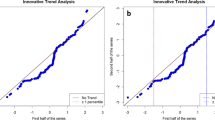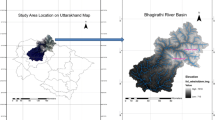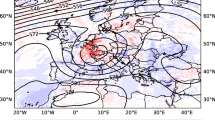Abstract
Precipitation shows that structured variation across space and time and the pattern of this variation is changing round the world due to global warming. These changes affect the water resources and hydrological cycle. A spatio-temporal dataset of precipitation records together with data on temperature, wind speed and humidity is used to analyze changes in spatiotemporal pattern of precipitation across 17 major meteorological stations of Punjab-Pakistan for monsoon period during 2004–2012. A distinguishable trend in precipitation structure along spatial and temporal domains is noticed. We consider a model-based bayesian spatio-temporal analysis using dynamic linear model and gaussian process model. The meteorological variables (covariates) temperature, wind speed and humidity show varying effect on the precipitation at different locations and time points. Additionally, we construct the spatial and temporal boxplots of all meteorological stations and time points to observe the distribution of precipitation and covariates at micro level. Further to this, the interval plots also reveal the spatially varying and temporally dynamic pattern of covariates. The prediction results through predictive contour plots show high and low precipitation zones in the study area and are helpful for policy makers to identify the homogeneous climate.








Similar content being viewed by others
References
Ahmad M, Chand S, Rafique HM (2016) Predicting the spatial distribution of sulfate concentration in groundwater of Jampur-Pakistan using geostatistical methods. Desalin Water Treat 3994:1–10. https://doi.org/10.1080/19443994.2016.1182076
Ailliot P, Thompson C, Thomson P (2009) Space–time modelling of precipitation by using a hidden Markov model and censored Gaussian distributions. J. R. Sta. Soc Ser C Appl Stat. 58:405–426
Ali A, Javed S, Ullah S, Fatima SH, Zaidi F, Khan MS (2018) Bayesian spatial analysis and prediction of groundwater contamination in Jhelum city (Pakistan). Environ Earth Sci. https://doi.org/10.1007/s12665-018-7253-5
Bakar KS (2011) Bayesian Analysis of Daily Maximum Ozone Levels. School of Mathematics, Faculty of Social and Human Sciences, University of Southampton
Bakar KS, Kokic P (2017) Bayesian Gaussian models for point referenced spatial and spatio-temporal data. J Stat Res. 51:17–40
Bakar KS, Kokic P, Jin H (2015) Hierarchical spatially varying coefficient and temporal dynamic process models using spTDyn. J Stat Comput Simul. https://doi.org/10.1080/00949655.2015.1038267
Collados-Lara A, Pardo-Igúzquiza E, Pulido-Velazquez D, Jiménez-Sánchez J (2018) Precipitation fields in an alpine Mediterranean catchment: inversion of precipitation gradient with elevation or undercatch of snowfall? Int J Climatol 38:3565–3578
Cressie N, Wikle CK (2015) Statistics for spatio-temporal data. Wiley Series in Probability and Statistics, Washington
Diggle P, Ribeiro PJ (2007) Model-based geostatistics. Springer Series in Statistics, Switzerland
Dou Y, Le ND, Zidek JV (2007) A dynamic linear model for hourly ozone concentrations, Technical Report. Univ. Br. Columbia 228
Dou Y, Le ND, Zidek JV (2010) Modeling hourly ozone concentration fields. Ann Appl Stat 4:1183–1213
Finley AO, Banerjee S, Gelfand AE (2012) Bayesian dynamic modeling for large space-time datasets using Gaussian predictive processes. J Geogr Syst 14:29–47
Finley AO, Banerjee S, Gelfand AE (2015) spBayes for large univariate and multivariate point referenced spatio-temporal data models. J Stat Soft 63:1–28
Goovaerts P (2000) Geostatistical approaches for incorporating elevation into the spatial interpolation of rainfall. J Hydrol 228:113–129
Harrison J, West M (1997) Bayesian forecasting & dynamic models. Springer, New York
Huerta G, Sansó B, Stroud JR (2004) A spatiotemporal model for Mexico City ozone levels. J R Stat Soc Ser C Appl Stat 53:231–248
Kalman RE (1960) A new approach to linear filtering and prediction problems. J Basic Eng Trans Am Soc Mech Eng 1:35–45
Krige GD (1951) A statistical approach to some basic mine valuation problems on the Witwatersrand. J Chem Metall Min Soc 52:119–139
Le ND, Zidek JV (1992) Interpolation with uncertain spatial covariances: a Bayesian alternative to kriging. J Multivar Anal 43:351–374
Le ND, Zidek JV (2006) Statistical analysis of environmental space-time processes. Springer Series in Statistics, Switzerland
Omre H, Halvorsen KB (1989) The Bayesian bridge between simple and universal kriging. Math Geol 21:767–786
Pardo-Igúzquiza E (1998) Comparison of geostatistical methods for estimating the areal average climatological rainfall mean using data on precipitation and topography. Int J Climatol 18:1031–1047
Petris G (2010) An R package for dynamic linear models. J Stat Softw 36:1–16
Petris G, Petrone S, Campagnoli P (2009) Dynamic linear models with R. Springer, New York
Sahu SK, Bakar KS (2012) A comparison of Bayesian models for daily ozone concentration levels. Stat Methodol 9:144–157
Shen X, Liu B, Lu X, Fan G (2016) Spatial and temporal changes in daily temperature extremes in China during 1960–2011. Appl Climatol, Theor. https://doi.org/10.1007/s00704-016-1934-3
Sigrist F, Hans RK, Stahel WA (2011) An autoregressive spatio-temporal precipitation model. Proc Environ Sci 3:2–7. https://doi.org/10.1016/j.proenv.2011.02.002
Sigrist F, Künsch HR, Stahel WA (2012) A dynamic nonstationary spatio-temporal model for short term prediction of precipitation. Ann Appl Stat 6:1452–1477
Stroud JR, Muller P, Sanso B (2001) Dynamic models for spatiotemporal data. J R Stat Soc Ser B Stat Methodol 63:673–689
Subyani AM (2004) Geostatistical study of annual and seasonal mean rainfall patterns in southwest Saudi Arabia. Hydrol Sci J 49:803–817
Wang R, Li C (2016) Spatiotemporal analysis of precipitation trends during 1961-2010 in Hubei province, central China. Theor Appl Climatol 124:385–399. https://doi.org/10.1007/s00704-015-1426-x
Wikle CK (2015) Modern perspectives on statistics for spatio-temporal data. Wiley Interdiscip Rev Comput Stat 7:86–98. https://doi.org/10.1002/wics.1341
Acknowledgements
We are grateful to Assistant Meteorologist, Regional Meteorological Centre Lahore for providing data on meteorological variables.
Author information
Authors and Affiliations
Corresponding author
Additional information
Publisher's Note
Springer Nature remains neutral with regard to jurisdictional claims in published maps and institutional affiliations.
Rights and permissions
About this article
Cite this article
Chand, S., Ahmad, M. Appraisal of spatial and temporal behavior in monsoon precipitation series of Punjab-Pakistan using hierarchical Bayesian Models. Environ Earth Sci 79, 304 (2020). https://doi.org/10.1007/s12665-020-09049-5
Received:
Accepted:
Published:
DOI: https://doi.org/10.1007/s12665-020-09049-5




